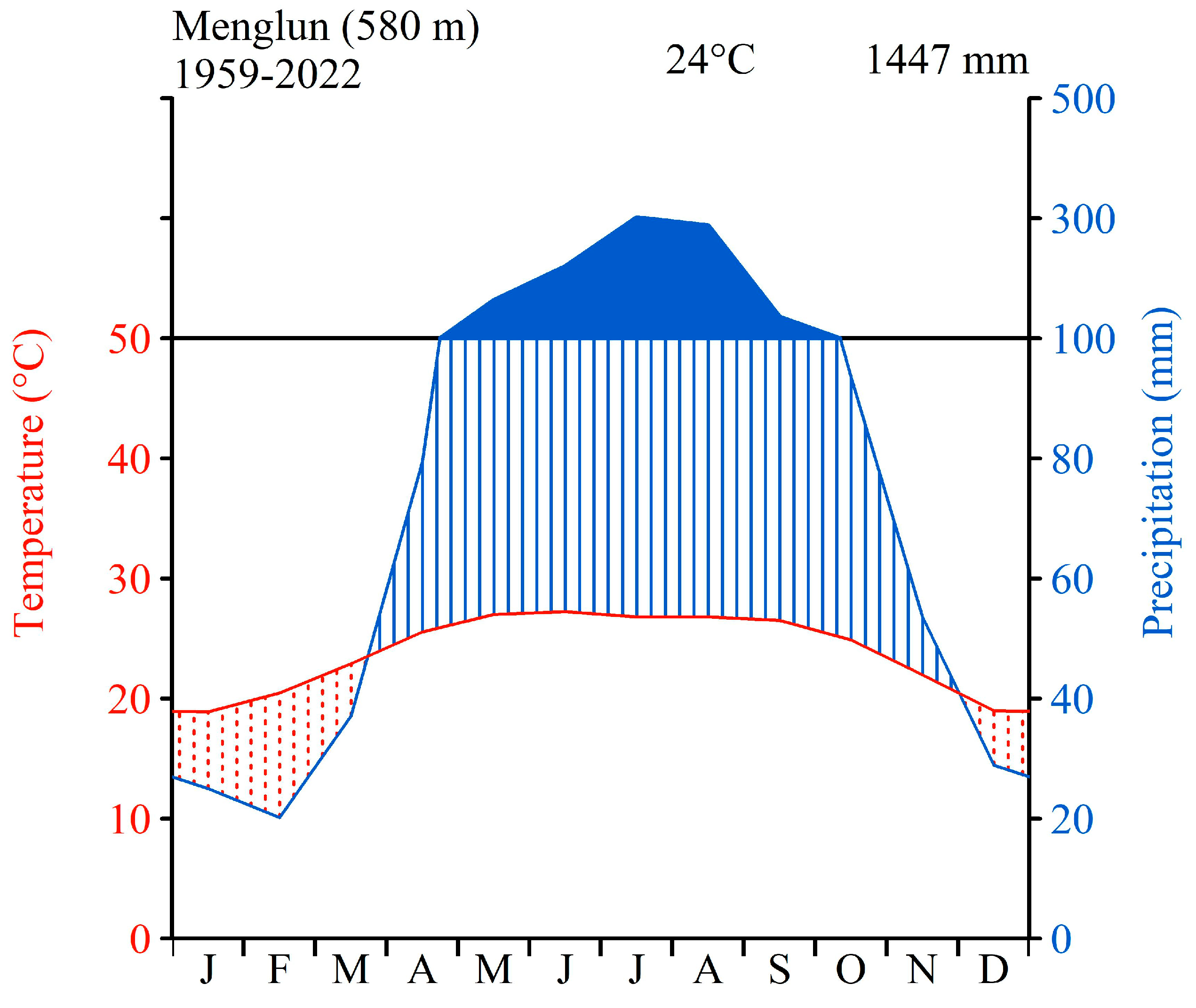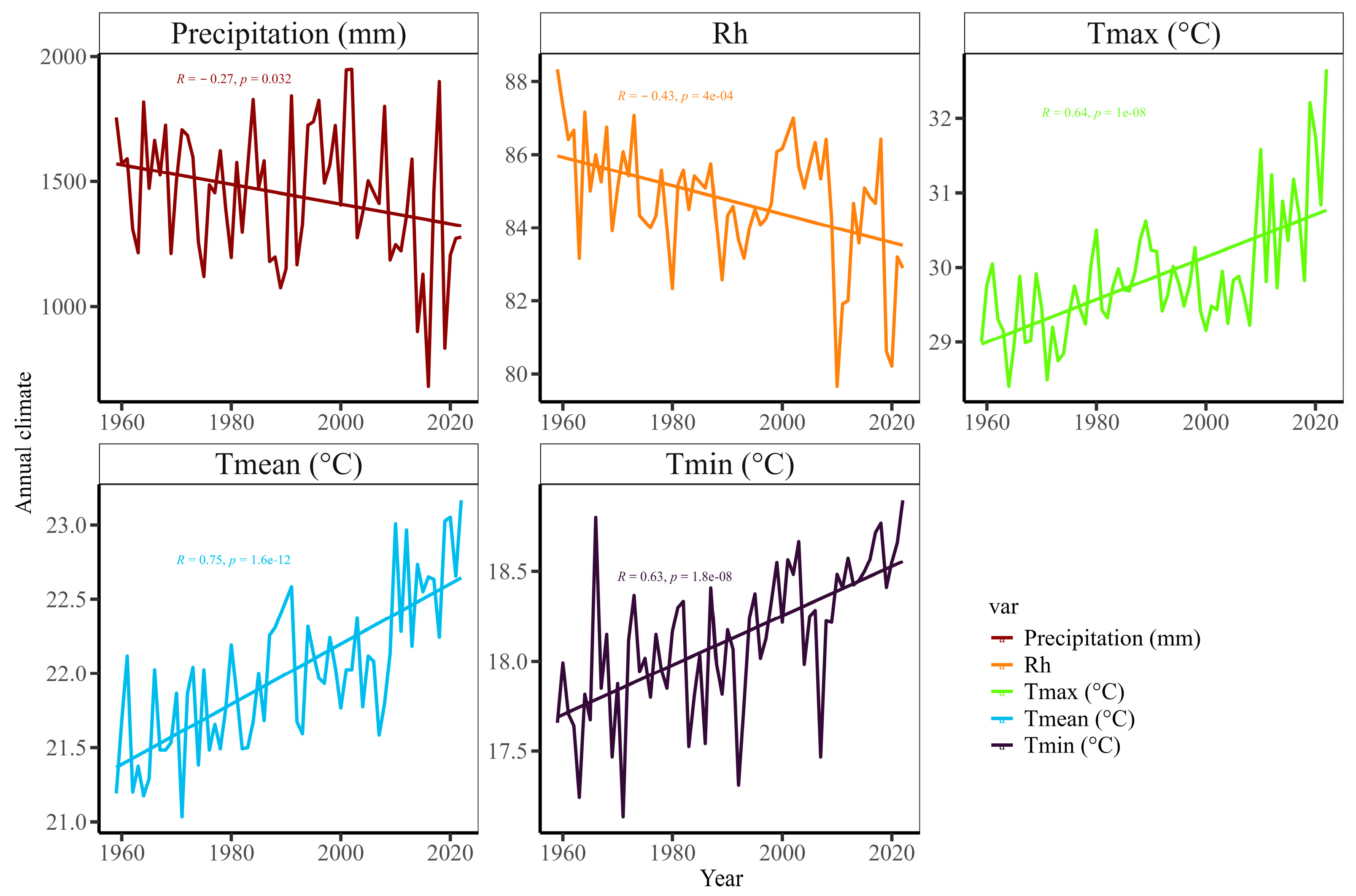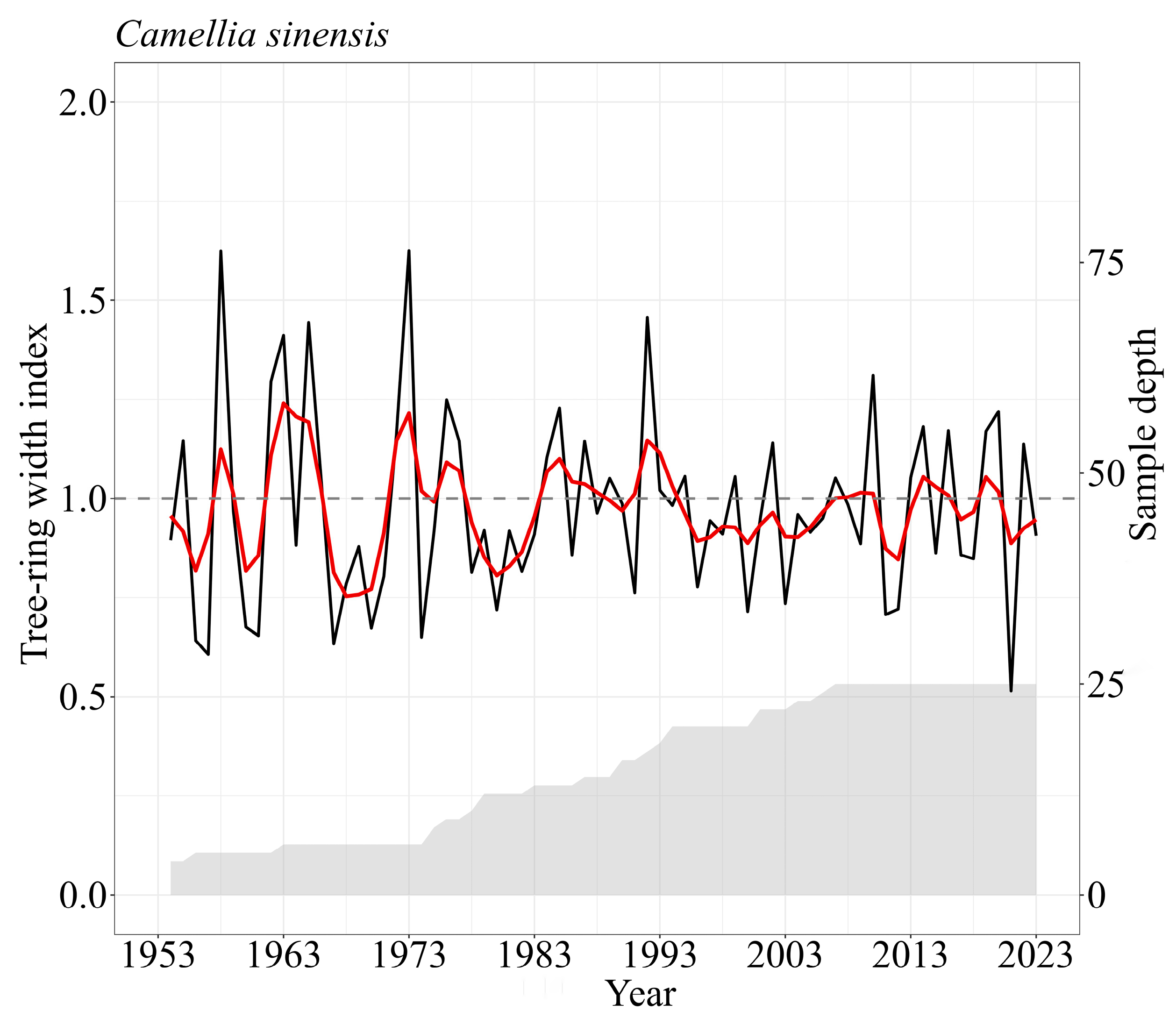The Response of the Annual Rotation Width of Tea Trees to Climate Change in the Brown Mountains of Yunnan Province
Abstract
1. Introduction
2. Materials and Methods
2.1. Research Materials
2.2. Research Methodology
2.2.1. Sample Collection
2.2.2. Measurement and Cross-Dating of Tree Annual Ring Widths
2.2.3. Establishment of Brown Mountain Tea Tree Chronology
2.2.4. Statistical Analyses
2.3. Overview of Study Area
2.3.1. Climatic Profile of Study Area
2.3.2. Climate Data Acquisition in the Study Area
3. Results
3.1. The Chronological Characterization of the Width of the Annual Rings
3.2. Relationship Between Radial Growth and Climate
3.3. Stability of Radial Growth and Climate Response
4. Discussion
5. Conclusions
Author Contributions
Funding
Data Availability Statement
Conflicts of Interest
References
- Climate Change 2013—The Physical Science Basis: Working Group I Contribution to the Fifth Assessment Report of the Intergovernmental Panel on Climate Change, 1st ed; Intergovernmental Panel On Climate Change, Ed.; Cambridge University Press: Cambridge, UK, 2014; ISBN 978-1-107-05799-9. [Google Scholar]
- Phillips, O.L.; Aragão, L.E.O.C.; Lewis, S.L.; Fisher, J.B.; Lloyd, J.; López-González, G.; Malhi, Y.; Monteagudo, A.; Peacock, J.; Quesada, C.A.; et al. Drought Sensitivity of the Amazon Rainforest. Science 2009, 323, 1344–1347. [Google Scholar] [CrossRef] [PubMed]
- Zaw, Z.; Fan, Z.-X.; Bräuning, A.; Liu, W.; Gaire, N.P.; Than, K.Z.; Panthi, S. Monsoon Precipitation Variations in Myanmar since AD 1770: Linkage to Tropical Ocean-atmospheric Circulations. Clim. Dyn. 2021, 56, 3337–3352. [Google Scholar] [CrossRef]
- Vlam, M.; Baker, P.J.; Bunyavejchewin, S.; Mohren, G.M.J.; Zuidema, P.A. Understanding Recruitment Failure in Tropical Tree Species: Insights from a Tree-Ring Study. For. Ecol. Manag. 2014, 312, 108–116. [Google Scholar] [CrossRef]
- Li, P.; Zhan, X.; Que, Q.; Qu, W.; Liu, M.; Ouyang, K.; Li, J.; Deng, X.; Zhang, J.; Liao, B.; et al. Genetic Diversity and Population Structure of Toona Ciliata Roem. Based on Sequence-Related Amplified Polymorphism (SRAP) Markers. Forests 2015, 6, 1094–1106. [Google Scholar] [CrossRef]
- Zuidema, P.A.; Heinrich, I.; Rahman, M.; Vlam, M.; Zwartsenberg, S.A.; van der Sleen, P. Recent CO2 Rise Has Modified the Sensitivity of Tropical Tree Growth to Rainfall and Temperature. Glob. Change Biol. 2020, 26, 4028–4041. [Google Scholar] [CrossRef]
- Zhang, M.G.; Zhou, Z.K.; Chen, W.Y.; Cannon, C.H.; Raes, N.; Slik, J.W.F. Major Declines of Woody Plant Species Ranges under Climate Change in Yunnan, China. Divers. Distrib. 2014, 20, 405–415. [Google Scholar] [CrossRef]
- Zuidema, P.A.; Brienen, R.J.W.; Schöngart, J. Tropical Forest Warming: Looking Backwards for More Insights. Trends Ecol. Evol. 2012, 27, 193–194. [Google Scholar] [CrossRef]
- He, M.; Yang, B.; Bräuning, A.; Rossi, S.; Ljungqvist, F.C.; Shishov, V.; Grießinger, J.; Wang, J.; Liu, J.; Qin, C. Recent Advances in Dendroclimatology in China. Earth-Sci. Rev. 2019, 194, 521–535. [Google Scholar] [CrossRef]
- Tang, J.X.; Wang, P.J.; E, Y.H.; Ma, Y.P.; Wu, D.R.; Hu, Z.G. Climatic Suitability Zoning of Tea Planting in Mainland China. J. Appl. Meteor. Sci. 2021, 32, 397–407. [Google Scholar] [CrossRef]
- Luo, X.Q.; Li, S.Y.; Wang, J.J.; Chen, X.Y.; Liang, M.Z.; Zhou, Y.Z.; Jiang, H.B. Survey of Ancient Tea Tree Resources in Xishuangbanna. Southwest J. Agric. 2013, 26, 46–51. [Google Scholar] [CrossRef]
- Dong, X.; Zhu, J.S. Globally Important Centre of Tea Tree Origins Yunnan Pu’er Jingmai Mountain Ancient Tea Forest Successful in Heritage Bidding. China Business News (Newspaper), 19 September 2023; A12. [Google Scholar]
- Bi, Y.; Xu, J.; Yang, J.; Li, Z.; Gebrekirstos, A.; Liang, E.; Zhang, S.; Yang, Y.; Yang, Y.; Yang, X. Ring-Widths of the above Tree-Line Shrub Rhododendron Reveal the Change of Minimum Winter Temperature over the Past 211 Years in Southwestern China. Clim. Dyn. 2017, 48, 3919–3933. [Google Scholar] [CrossRef]
- Brienen, R.; Gloor, M.; Zuidema, P. Can We Detect Evidence for CO2 Fertilization from Tree Rings? Glob. Biogeochem. Cycles Int. J. Glob. Change 2012. [Google Scholar] [CrossRef]
- Dietrich, R.; Anand, M. Trees Do Not Always Act Their Age: Size-Deterministic Tree Ring Standardization for Long-Term Trend Estimation in Shade-Tolerant Trees. Biogeosciences 2019, 16, 4815–4827. [Google Scholar] [CrossRef]
- Herrera-Ramirez, D.; Andreu-Hayles, L.; del Valle, J.I.; Santos, G.M.; Gonzalez, P.L.M. Nonannual Tree Rings in a Climate-Sensitive Prioria Copaifera Chronology in the Atrato River, Colombia. Ecol. Evol. 2017, 7, 6334–6345. [Google Scholar] [CrossRef] [PubMed]
- Cook, E.R. A Time Series Analysis Approach to Tree Ring Standardization (Dendrochronology, Forestry, Dendroclimatology, Autoregressive Process). Ph.D. Thesis, University of Arizona, Tucson, AZ, USA, 1985. [Google Scholar]
- Bunn, A.G. A Dendrochronology Program Library in R (dplR). Dendrochronologia 2008, 26, 115–124. [Google Scholar] [CrossRef]
- Zang, C.; Biondi, F. Dendroclimatic Calibration in R: The bootRes Package for Response and Correlation Function Analysis. Dendrochronologia 2013, 31, 68–74. [Google Scholar] [CrossRef]
- Thomas, A. The Onset of the Rainy Season in Yunnan Province, PR China and Its Significance for Agricultural Operations. Int. J. Biometeorol. 1993, 37, 170–176. [Google Scholar] [CrossRef]
- Li, Y.; He, D.; Hu, J.; Cao, J. Variability of Extreme Precipitation over Yunnan Province, China 1960–2012. Int. J. Climatol. 2015, 35, 245–258. [Google Scholar] [CrossRef]
- Julian, P.; Fritts, H. On the Possibility of Quantitatively Extending Precipitation Records by Means of Dendroclimatological Analysis; National Center for Atmospheric Research: Boulder, Colorado, 1968. [Google Scholar]
- Zhang, Z. Tree-Rings, a Key Ecological Indicator of Environment and Climate Change. Ecol. Indic. 2015, 51, 107–116. [Google Scholar] [CrossRef]
- Liu, X.; Nie, Y.; Wen, F. Seasonal Dynamics of Stem Radial Increment of Pinus Taiwanensis Hayata and Its Response to Environmental Factors in the Lushan Mountains, Southeastern China. Forests 2018, 9, 387. [Google Scholar] [CrossRef]
- Fontana, C.; Santini-Junior, L.; Olmedo, G.M.; Botosso, P.C.; Tomazello-Filho, M.; Oliveira, J.M. Assessment of the Dendrochronological Potential of Licaria Bahiana Kurz, an Endemic Laurel of Lowland Atlantic Forests in Brazil. Acta Bot. Bras. 2019, 33, 454–464. [Google Scholar] [CrossRef]
- Bai, X.; Fan, Z.-X. Response of Tree Ring Width to Climate Change of Tetracentron Sinensis in Humid Evergreen Broad-Leaved Forest in the Middle Ailao Mountains. Linye Kexue/Sci. Silvae Sin. 2018, 54, 161–167. [Google Scholar] [CrossRef]
- Su, H.; Axmacher, J.C.; Yang, B.; Sang, W. Differential Radial Growth Response of Three Coexisting Dominant Tree Species to Local and Large-Scale Climate Variability in a Subtropical Evergreen Broad-Leaved Forest of China. Ecol. Res. 2015, 30, 745–754. [Google Scholar] [CrossRef]
- Zhou, B.; Fan, Z.X.; Qi, J.H. Intra-annual radial growth of evergreen and deciduous tree species and their response to climatic factors in a montane moist evergreen broad-leaved forest in the Ailao Mountains, Southwest China. Ecol. Lett. 2020, 40, 1699–1708. [Google Scholar]
- Pavão, D.C.; Jevšenak, J.; Engblom, J.; Borges Silva, L.; Elias, R.B.; Silva, L. Tree Growth-Climate Relationship in the Azorean Holly in a Temperate Humid Forest with Low Thermal Amplitude. Dendrochronologia 2023, 77, 126050. [Google Scholar] [CrossRef]
- Huang, J.-G.; Guo, X.; Rossi, S.; Zhai, L.; Yu, B.; Zhang, S.; Zhang, M. Intra-Annual Wood Formation of Subtropical Chinese Red Pine Shows Better Growth in Dry Season than Wet Season. Tree Physiol. 2018, 38, 1225–1236. [Google Scholar] [CrossRef]
- Yu, J.; Chen, J.J.; Meng, S.W.; He, H.J.; Zhao, Y.S.; Zhang, P.; Yang, B.; Liu, Q.J. Reconstruction of April-July precipitation changes in northern Daxinganling over the past 242 years based on tree annual rings. Quat. Stud. 2024, 44, 895–907. [Google Scholar]
- Zhou, P.; Huang, J.-G.; Liang, H.; Rossi, S.; Bergeron, Y.; Shishov, V.V.; Jiang, S.; Kang, J.; Zhu, H.; Dong, Z. Radial Growth of Larix Sibirica Was More Sensitive to Climate at Low than High Altitudes in the Altai Mountains, China. Agric. For. Meteorol. 2021, 304–305, 108392. [Google Scholar] [CrossRef]
- Dang, H.; Jiang, M.; Zhang, Q.; Zhang, Y. Growth Responses of Subalpine Fir (Abies Fargesii) to Climate Variability in the Qinling Mountain, China. For. Ecol. Manag. 2007, 240, 143–150. [Google Scholar] [CrossRef]
- Masson-Delmotte, V.P.; Zhai, P.; Pirani, S.L.; Connors, C.; Péan, S.; Berger, N.; Caud, Y.; Chen, L.; Goldfarb, M.I.; Scheel Monteiro, P.M. IPCC, 2021: Summary for Policymakers. In Climate Change 2021: The Physical Science Basis. Contribution of Working Group I to the Sixth Assessment Report of the Intergovernmental Panel on Climate Change; Intergovernmental Panel on Climate Change: Geneva, Switzerland, 2021. [Google Scholar]
- Wang, L.; Liu, H.Y. Application of tree-wheel stable oxygen isotopes in soil moisture reconstruction and future challenges. Quat. Stud. 2021, 1–10. [Google Scholar] [CrossRef]





| Statistical Characteristics | |
|---|---|
| Time span | 1954–2023 |
| Average annual growth rate (mm/year) | 1.283 |
| First-order autocorrelation coefficient (ACI) | 0.269 |
| Average sensitivity (MS) | 0.514 |
| Signal-to-noise ratio (SNR) | 2.526 |
| Sequence correlation (Rbar) | 0.112 |
| Expressed population signal (EPS) | 0.716 |
Disclaimer/Publisher’s Note: The statements, opinions and data contained in all publications are solely those of the individual author(s) and contributor(s) and not of MDPI and/or the editor(s). MDPI and/or the editor(s) disclaim responsibility for any injury to people or property resulting from any ideas, methods, instructions or products referred to in the content. |
© 2024 by the authors. Licensee MDPI, Basel, Switzerland. This article is an open access article distributed under the terms and conditions of the Creative Commons Attribution (CC BY) license (https://creativecommons.org/licenses/by/4.0/).
Share and Cite
Wu, X.; Hu, H.; Liang, D.; Fu, P.; Qin, L. The Response of the Annual Rotation Width of Tea Trees to Climate Change in the Brown Mountains of Yunnan Province. Agronomy 2024, 14, 2913. https://doi.org/10.3390/agronomy14122913
Wu X, Hu H, Liang D, Fu P, Qin L. The Response of the Annual Rotation Width of Tea Trees to Climate Change in the Brown Mountains of Yunnan Province. Agronomy. 2024; 14(12):2913. https://doi.org/10.3390/agronomy14122913
Chicago/Turabian StyleWu, Xiaolong, Haibo Hu, Di Liang, Peili Fu, and Lei Qin. 2024. "The Response of the Annual Rotation Width of Tea Trees to Climate Change in the Brown Mountains of Yunnan Province" Agronomy 14, no. 12: 2913. https://doi.org/10.3390/agronomy14122913
APA StyleWu, X., Hu, H., Liang, D., Fu, P., & Qin, L. (2024). The Response of the Annual Rotation Width of Tea Trees to Climate Change in the Brown Mountains of Yunnan Province. Agronomy, 14(12), 2913. https://doi.org/10.3390/agronomy14122913





